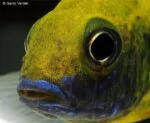Aulonocara baenschi
Aulonocara baenschi is named after the German ichthyologist Hans A. Baensch. Aulonocara comes from ancient Greek; aulos = flute and caras is face and refer to the lateral line channels that resemble the holes of a flute.
This bright yellow-colored peacock will certainly be an asset to your Malawi stock. Due to its tough nature, it can also be kept together with the larger Utaka, but it is preferable not to keep it in a very busy Mbuna aquarium because then it will languish.
As with most Aulonocara, it will chase the female to mate, so give her enough hiding places in the form of enough rocks with caves and crevices in between. To spread the pressure on the females, it is best to keep a male with two or three females.
This species is very similar to the Aulonocara stuartgranti Maleri, but the baenschi has a somewhat rounder forehead, compared to the flattened forehead of the Aulonocara stuartgranti Maleri.
Biotope
They are sometimes called Nkhomo-Benga peacock, which is why the name Aulonocara baenschi Benga occasionally appears. Aulonocara baenschi comes from Nkhomo Reef, near the village of Benga (hence the name baenschi Benga). There it inhabits the sandy substrates with scattered boulders. Here the males defend an excavated pit. The females live alone or in groups but have no territory to defend.
Diet
In the wild Aulonocara baenschi Benga feeds on animals that it filters out of the sand, so a sandy substrate is definitely recommended. It will show its natural behavior best over sand.
In the wild, the baenschi remains a bit smaller at about 9 centimeters than in the aquarium where it can grow up to 14-15 centimeters. This is mainly caused by the large supply of powerful food.
Breeding
The male digs a shallow breeding pit and lures females to the breeding pit by displaying his beautiful breeding colors and swimming ahead of them. The breeding colors are more or less preserved all year round. The gray females reside in groups or solitary.
The actual mating act is the same as the normal mouth-brooding tactic. The females lay eggs which they immediately take into their mouths. The male fertilizes the eggs by adding his sperm. The eggs are hatched in the female’s mouth, and after about 21 days the fry are released. After that, there is no more brood care.
Because the Aulonocara females are very similar, it is inevitable that different species will interbreed. To keep the species pure, it is therefore advisable to keep only one Aulonocara species per aquarium.
Video
Author
J. de Lange – Patman
Copyright images
Gerry Verrier, J. de Lange (eigenaar vis: Menno van den Brink)















Reviews
There are no reviews yet.